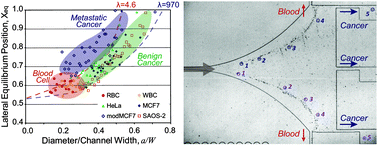The ability to detect and isolate rare target cells from heterogeneous samples is in high demand in cell biology research, immunology, tissue engineering and medicine. Techniques allowing label-free cell enrichment or detection are especially important to reduce the complexity and costs towards clinical applications. Single-cell deformability has recently been recognized as a unique label-free biomarker for cell phenotype with implications for assessment of cancer invasiveness. Using a unique combination of fluid dynamic effects in a microfluidic system, we demonstrate high-throughput continuous label-free cell classification and enrichment based on cell size and deformability. The system takes advantage of a balance between deformability-induced and inertial lift forces as cells travel in a microchannel flow. Particles and droplets with varied elasticity and viscosity were found to have separate lateral dynamic equilibrium positions due to this balance of forces. We applied this system to successfully classify various cell types using cell size and deformability as distinguishing markers. Furthermore, using differences in dynamic equilibrium positions, we adapted the system to conduct passive, label-free and continuous cell enrichment based on these markers, enabling off-chip sample collection without significant gene expression changes. The presented method has practical potential for high-throughput deformability measurements and cost-effective cell separation to obtain viable target cells of interest in cancer research, immunology, and regenerative medicine.

You have access to this article
 Please wait while we load your content...
Something went wrong. Try again?
Please wait while we load your content...
Something went wrong. Try again?


 Please wait while we load your content...
Please wait while we load your content...